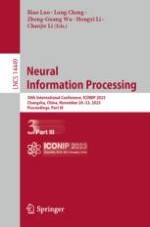2024 | Book
Neural Information Processing
30th International Conference, ICONIP 2023, Changsha, China, November 20–23, 2023, Proceedings, Part III
Editors: Biao Luo, Long Cheng, Zheng-Guang Wu, Hongyi Li, Chaojie Li
Publisher: Springer Nature Singapore
Book Series : Lecture Notes in Computer Science
